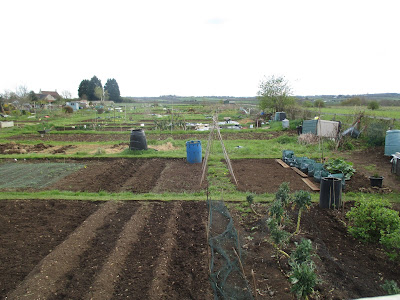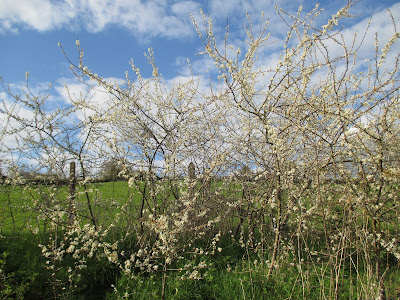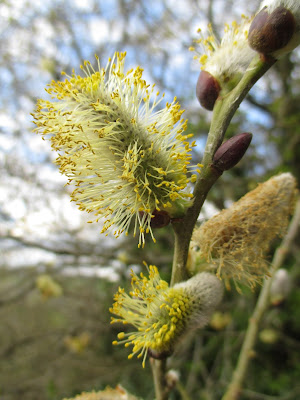First of all, thank you everyone for your good wishes and very kind comments on my last post, celebrating my second Blogaversary. I was so touched by the lovely things you said about my blog. They made me very happy indeed.
Yesterday we decided to leave the car at home and go for a walk from our door. The sun was shining and, although there was a nip in the air, billowy white clouds were drifting across a deep blue sky. We just couldn’t be indoors, so we set off across the fields near to where we live.
I love hedgerows. They burst into life when spring is at its height, frothing with white blackthorn blossom and fresh green leaves.
Beneath them are spring flowers: celandines, primroses and if you’re lucky, some native bluebells.
Later on into the summer they teem with more plants, and they are corridors for small creatures, making a network of mini highways across the countryside traversed by insects, birds and small mammals, all mostly unseen by humans. The more species which make up a hedgerow, the older it is.
Prettily-coloured cows grazed in the valley,
and then at the top of the hill the land became more scrubby and we came across bright yellow gorse in bloom.
In this part of Somerset the countryside is gentle and hilly, rolling and undulating away to the horizon. We live in the Somerset Coalfield amid a cluster of old mining towns. The last mines closed in the 1960s and 70s but many men in the local towns are ex-miners with very interesting stories to tell. Most of the older housing consists of terraced miner’s cottages built from local stone, and we are surrounded by old pits which are very much a part of the landscape, a reminder of the area’s industrial heritage. Beneath the ground in places there are mine-shafts and, indeed, if you buy a house in this area you have to have a coal-mining search done at the same time to check for the likelihood of subsidence. My elderly ex-neighbour told me stories of an underground passageway running under our gardens wide enough for a horse and cart to travel through, as we live close to an old pit. I try not to think too much about that when I’m gardening!
Soon we neared a village and came across some neatly-ordered allotments, looking ready for the growing season ahead.
The area is made up of carboniferous limestone which originates in prehistoric times, and we often dig up large pieces of limestone in the garden and use the larger ones for little pathways and borders. Once we found one with a little ammonite embedded in it. We walked down towards the little town of Radstock which contains an old mining wheel, mining museum and gives its name to a prehistoric variety of giant dragonfly with a wingspan of 40cm which was discovered there. Firstly though, we detoured into a tiny, old quarry to explore.
Once inside, its rocky walls stood just above head-height with trees suspended above us as we walked.
The information board explained that the whole area had been an archipelago of islands in a swampy tropical sea, and this is why it's is so rich in fossils and coal.
As we walked we scanned the large rocks scattered on the ground and spotted some tiny shells outlined in the rock as well as some glittery quartz.
As we walked into Radstock we passed this churchyard which has a tree growing out of a wall,
and met this sweet, spotty little pig - aaaah!
One in the town we stopped for a cup of tea, as our legs were ready for a rest. A network of old railway lines criss-cross the area after the railways were closed in the 1960s, and in recent years have been brilliantly transformed into cycle tracks and 'greenways', linking the towns and villages with each other. We headed for home along one such greenway, crossing a river and walking under railway arches with wonderful fields surrounding us.
More beautiful hedgerows.
This is the field that J and I crossed on our walk last April.
We crossed over the river,
and started our uphill journey into more wooded countryside. We managed to correctly identify a dipper on a rock in the river and a tree creeper doing what it's name suggests, creeping all the way to the top of a very tall tree. Sadly they were too fast-moving for me to produce any decent photoss of these birds.
All around us spring was bursting forth.
In the distance is more evidence of the area's mining history. Waste from the mines was piled into spoil tips which are known locally as 'batches'.
After a while our walk took us along a raised walkway at treetop height and we listened to the birds all around us. I think this walkway is a great idea - it gives you a different perspective on your surroundings.
It was good to see these bat boxes fixed high up in the trees, as well as plenty of nesting boxes for birds.
When we got home, we worked out that we'd covered about 5 miles. It reminded us of how much there is of interest on our doorstep if we look for it, and we decided we must do it more often.
The weather had been lovely all afternoon, the landscape pretty and its history fascinating - you can't ask for more than that!































What a stunning walk! Absolutely gorgeous, perfect Sunday activity :) xx
ReplyDeleteLovely photos of a wonderful walk. I hadn't realised that Somerset had a mining background. I was born in Leicestershire and my late husband was born in mining country, his father and 8 brothers all miners - imagine their shock when my husband joined the Police Force!!!
ReplyDeleteI've been following your blog for ages and thought I was a 'Follower' - but I wasn't, so I signed in just now, rather late!!!
What a lovely walk - I love that raised walkway too. How interesting that you have an underground passage beneath your garden; I love a bit of history like that. We have a Roman road beneath ours, it just means that you can't dig down very far in certain places. I wish that my veggie patch looked as neat as those allotments! Have a great week. xx
ReplyDeleteI really enjoyed following you on your walk around your local area - it is fascinating to read about different parts of the country and the history of the area. I would love to walk on the raised walkway and it is great that the old railway trackbeds have been turned into walkways/cycleways. xx
ReplyDeleteSuch a lovely walk. I walk my dog past the hedgerows from my childhood. Always a pleasure to see how they have changed over the years xx
ReplyDeleteThis is a wonderful country isn't it, we are so lucky to have all this beautiful ever-changing countryside around us. x
ReplyDeleteWhat a wonderful walk , seeing the photos I felt I was with you, it is good to get out and be in the great outdoors it always makes me feel better, the piggy is so cute xx
ReplyDeleteWhat a beautiful part of the world you live in. This country is so diverse in its landscape we are very lucky and although I love to travel I would not want to live permanently any where other than the UK. More UK exploring coming up this year I think for me
ReplyDeleteSuch lovely photos! I enjoyed seeing a bit of English countryside through your eyes. The hedgerow photos are delightful!
ReplyDeleteSo lovely to go exploring with you!!
ReplyDeleteNo wonder the outdoors was calling to you, your part of the world is lovely.
ReplyDeleteAmalia
xo
Cathy please take a look at my blog, I have nominated you for an award xx
ReplyDelete